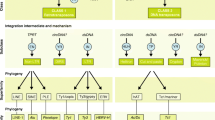Abstract
During gametogenesis, chromosomes may become imprinted with information which facilitates proper expression of the DNA in offspring. We have used a position effect variegation mutant as a reporter system to investigate the possibility of imprinting inDrosophila melanogaster. Genetic crosses were performed in which the variegating gene and a strong modifier of variegation were present either within the same parental genome or in opposite parental genomes in all possible combinations. Our results indicate that the presence of the variegating chromosome and a modifier chromosome in the same parental genome can alter the amount of variegation formed in progeny. The genomic imprinting we observed is not determined by the parental origin of the variegating chromosome but is instead determined by the genetic background the variegating chromosome is subjected to during gametogenesis.
Similar content being viewed by others
References
Bird, A.P. & M.H. Taggart, 1980. Variable patterns of total DNA and rDNA methylation in animals. Nucleic Acids Res. 8: 1485–1497.
Bishop, C.P., 1992. Evidence for intrinsic differences in the formation of chromatin domains inDrosophila melanogaster. Genetics 132: 1063–1069.
Cattanach, B.M., 1974. Position effect variegation in the mouse. Genet. Res. Camb. 23: 291–222.
Cooper, D.W., J.J. VandeBurg, G.B. Sharman & W.F. Poole, 1971. Phosphoglycerate kinase polymorphism in kangaroo provides further evidence for paternal X inactivation. Nature New Biol. 230: 155–157.
Edgar, B.A. & G. Schubiger, 1986. Parameters controlling transcriptional activation during earlyDrosophila development. Cell 44: 871–877.
Ephrussi, B. & J.L. Herold, 1944. Studies of eye pigment ofDrosophila. I. Methods of extraction and quantitative estimation of the pigment components. Genetics 29: 148–175.
Foe, V.E., G.M. Odell & B.A. Edgar, 1993. In. The development ofDrosophila melanogaster, pp. 149–300 edited by M. Bate & A.M. Arias. Cold Spring Harbor Laboratory Press, New York.
Kaslow, D.C. & B.R. Migeon, 1987. DNA methylation stabilizes X chromosome inactivation in eutherians but not in marsupials: Evidence for multistep maintenance of mammalian X dosage compensation. Proc. Natl. Acad. Sci. USA 84: 6210–6214.
Knoll, J.H.M., R.D. Nicholls, R.E. Magenis, J.M. Graham, M. Lalande & S.A. Latt, 1989. Angelman and Prader-Willi syndromes share a common chromosome 15 deletion but differ in parental origin of deletion. Amer. Jour. Med. Genet. 32: 285–290.
Lock, L.F., N. Takagi & G.R. Martin, 1987. Methylation of the Hprt gene on the inactive X occurs after chromosome inactivation. Cell 48: 39–46.
Locke, J., M.A. Kotarski & K. Tartof, 1988. Dosage-dependent modifiers of position effect variegation inDrosophila and a mass action model that explains their effects. Genetics 120: 181–198.
Reuter, G. & P. Spierer, 1992. Position effect variegation and chromatin proteins. BioEssays 14: 605–612.
Reuter, G., I. Wolff & B. Friede, 1985. Functional properties of the heterochromatin sequences including wm4 position-effect inDrosophila melanogaster. Chromosoma 93: 132–139.
Richardson, B.J., A.B. Czuppon & G.B. Sharman, 1971. Inheritance of glucose-6-phosphate dehydrogenase variation in kangaroos. Nature New Biol. 230: 154–155.
Sapienza, C., 1989. Genome imprinting and dominance modification. Ann. N.Y. Acad. Sci. 564: 24–36.
Scrable, H., W. Cavenee, F. Ghavimi, M. Lovell, K. Morgan & C. Sapienza, 1989. A model for embryonal rhabdomyosaccoma tumorigenesis that involves genome imprinting. Proc. Natl. Acad. Sci. USA 86: 7480–7484.
Spofford, J.B., 1976. Position effect variegation inDrosophila. In: The Genetics and Biology of Drosophila Vol. 1c, pp 955–1018. Edited by M. Ashburner & E. Novitski. Academic Press, New York.
Takagi, N. & M. Sasaki, 1975. Preferential expression of the paternally derived X chromosome in the extra-embryonic membranes in the mouse. Nature 256: 640–642.
Urieli-Shoval, S., Y. Gruenbaum, J. Sedat & A. Razin, 1982. The absence of detectable methylated bases inDrosophila melanogaster DNA. FEBS Lett. 146: 148–152.
Author information
Authors and Affiliations
Rights and permissions
About this article
Cite this article
Bishop, C.P., Jackson, C.M. Genomic imprinting of chromatin inDrosophila melanogaster . Genetica 97, 33–37 (1996). https://doi.org/10.1007/BF00132578
Received:
Accepted:
Issue Date:
DOI: https://doi.org/10.1007/BF00132578




